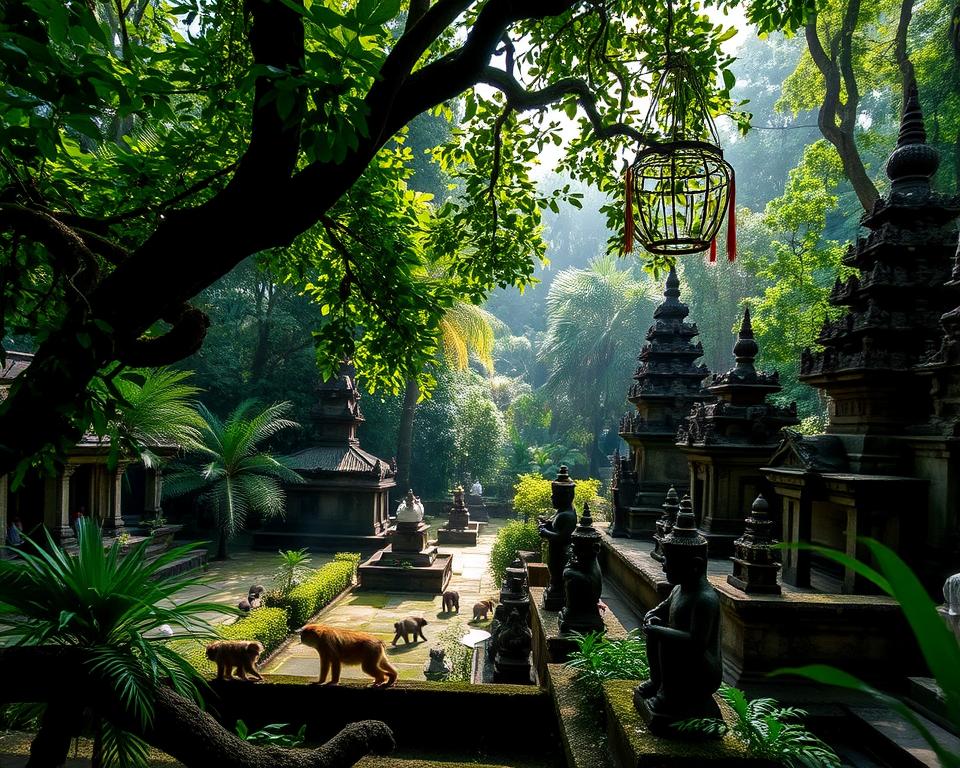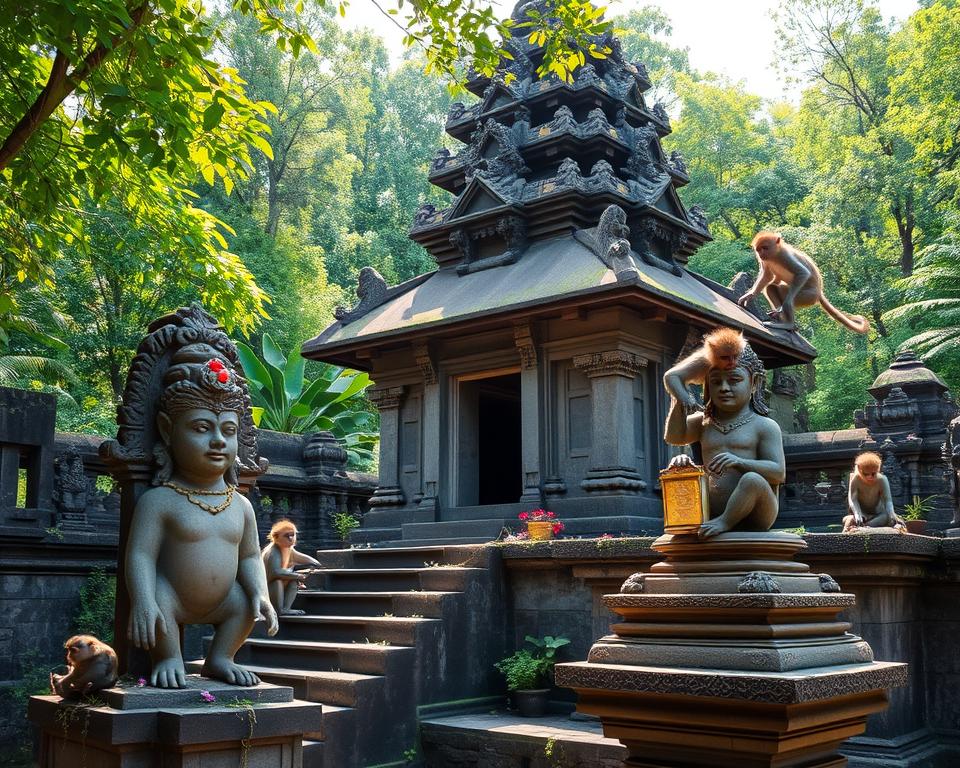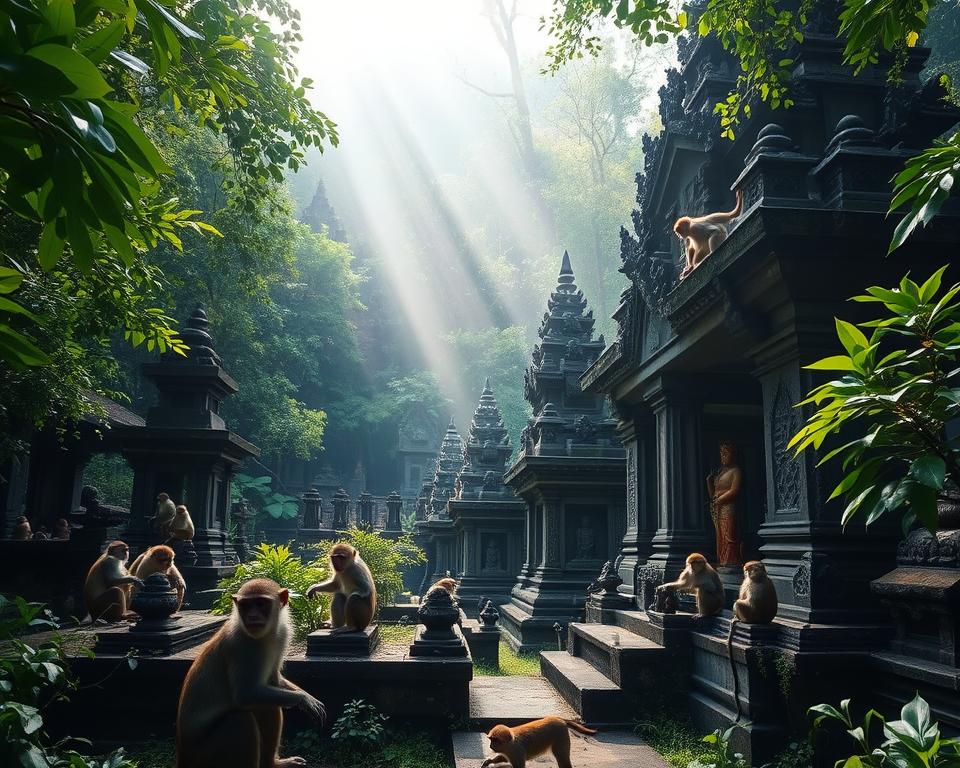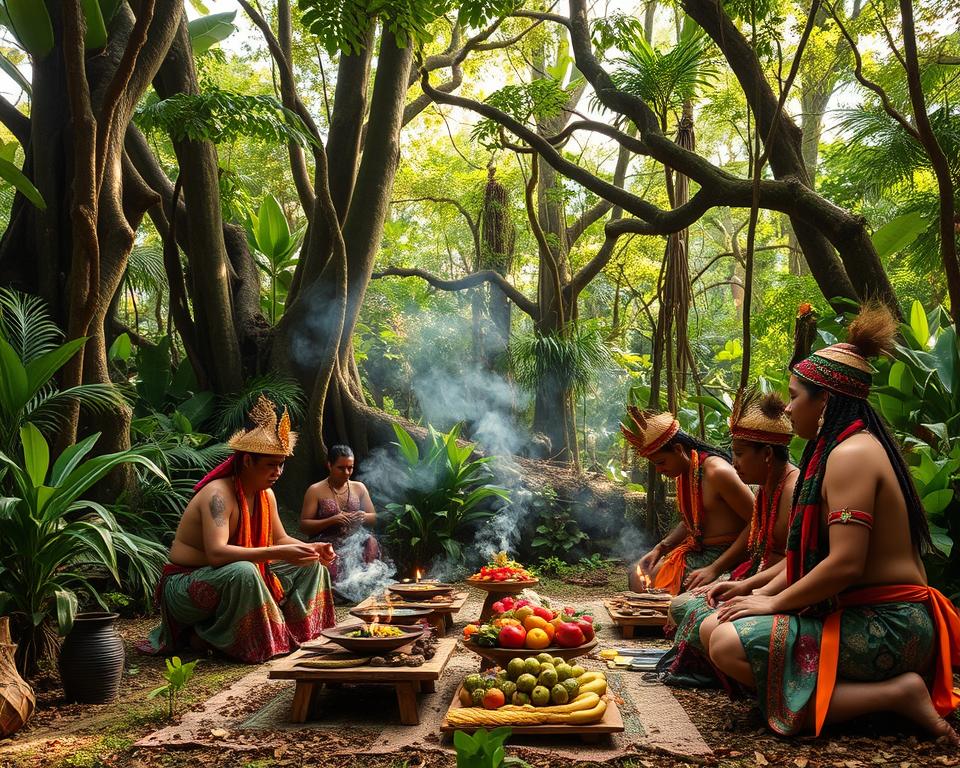
How is the Ubud Monkey Forest linked to Balinese Hinduism?
Ever wondered why monkeys are sacred in Bali? The Ubud Monkey Forest is a sacred monkey sanctuary linked to Balinese Hinduism. It’s a place of deep spiritual meaning, dating back to the 14th century. Here, you’ll find 1,200 long-tailed macaques, temples, and rituals that show Bali’s rich heritage12.
The forest is full of life, with 115 tree species important to Bali’s spirituality1. Walking through, you see shrines and trees that connect nature and spirit. This shows how Balinese Hinduism is part of daily life in Bali1. Learn more about this magical place and why it’s more than just a tourist spot.
Key Takeaways
- The Ubud Monkey Forest dates back to the 14th century, showcasing its historical significance.
- It is home to around 1,200 macaque monkeys, making it a vital conservation area.
- The forest features 115 species of trees, many of which have sacred significance.
- Ritual activities in the forest reflect the philosophy of Tri Hita Karana.
- Visitors are encouraged to engage with the cultural practices observed in the sanctuary.
- The entry fee varies between weekdays and weekends, making accessibility important.
Introduction to Ubud Monkey Forest
The Ubud Monkey Forest is a must-see in Bali’s Ubud region. It covers about 12.5 hectares and is home to 1,260 Balinese long-tailed macaques. These monkeys live in 10 groups, based on age and gender3.
The forest is full of life, with over 186 species of plants. It shows off Bali’s natural beauty3. Every month, 10,000 to 15,000 visitors come to see it. It’s a chance to learn about Bali’s culture.
The Ubud Monkey Forest started in the 1930s4. It’s now a key place for protecting monkeys and rare plants4. The local Padangtegal village looks after it, using money from visitors to help conservation4.
Visitors can join guided tours and even feed the monkeys. But, it’s not easy for everyone to get around4. It’s in Central Bali, offering a mix of nature, culture, and adventure.
Historical Significance of the Ubud Monkey Forest
The Ubud Monkey Forest has a long history, starting in the 14th century. It was a sacred place before Indonesia was formed. Today, it’s a key spot for conservation and home to 600 Balinese long-tailed macaque monkeys5.
It covers 12.5 hectares and has over 115 tree species. This shows the rich biodiversity and cultural heritage of Balinese culture5.

Origins and Evolution
The Ubud Monkey Forest has changed a lot over time. It was once a sacred site, now it focuses on conservation. This shows the community’s dedication to preserving its history and nature5.
This change reflects Balinese culture’s belief in nature and spirituality. The forest has three temples, each for different deities. They follow traditional Balinese architecture and Hindu teachings56.
The Role of Monkeys in Balinese Culture
Monkeys in Balinese culture are symbols of both protection and mischief. They are seen as guardian spirits in the Ubud Monkey Forest. Their role goes beyond just being symbols; they are key in local myths and dances6.
Lord Hanuman, the monkey god, is a central figure in many stories. This highlights the monkeys’ significant role in Balinese history and culture6.
An Overview of Balinese Hinduism
Balinese Hinduism is a mix of Hindu, Buddhist, and Indonesian traditions. It’s a rich spiritual mix. It focuses on worshipping gods, honouring ancestors, and finding harmony in life.
Everyday rituals and ceremonies are key to keeping balance in the world.
Core Beliefs and Practices
The Supreme God is at the centre of Balinese Hinduism. People worship and follow many rituals to honour this God. Ancestral spirits also guide the community, linking the living to the dead.
Rituals are a big part of daily life to please these spirits.
Visitors to the Sacred Monkey Forest see these practices up close. The forest is 27 acres big and is a key spot for nature and rituals. It has over 700 monkeys and many plants, showing the community’s care for nature and culture that enhances their cultural practices7.
The temples in the forest are from the 14th century. They are important for ceremonies. Each temple, like Pura Dalem Agung Padangtegal for Shiva, shows the deep link between rituals and spiritual guidance in Balinese Hinduism8.
How is the Ubud Monkey Forest linked to Balinese Hinduism?
The Ubud Monkey Forest is a special place. It shows how monkeys and Balinese beliefs are connected. Here, monkeys are seen as spiritual guardians of the forest.
Their presence helps people believe in divine protection. It also shows how living beings can live together in harmony.
The Spiritual Guardianship of Monkeys
At the heart of Ubud Monkey Forest spirituality is a deep respect for nature. Monkeys are seen as protectors of this sacred place. They play important roles in Balinese rituals, showing their value in the culture.
Visitors are asked to respect this special bond. They should also care for the environment, just like the Balinese do.
Some trees, like Majegan and Pule Bandak, are very important here. They are used in ceremonies and as offerings. Today, over 600 macaques live here, showing a strong bond between humans and wildlife1.
Thanks to visitors, the forest is protected. It follows the idea of Tri Hita Karana, which is about balance in life, nature, and the divine.

This bond with monkeys makes the Ubud Monkey Forest famous. It’s a place where you can see monkeys and learn about local beliefs. By caring for this relationship, the forest shows the importance of monkeys as spiritual guardians910.
The Temples within the Monkey Forest
The Ubud Monkey Forest is a special place. It’s home to long-tailed macaques and is important for cultural and spiritual rituals. The temples here play a big role in Balinese Hindu traditions. They host ceremonies that bring the community together.
Delving into the Three Main Temples
The Dalem Agung Padangtegal Temple is dedicated to Shiva. It’s key for local rituals. Beji Temple is linked to a holy spring and is for purification rituals. The Prajapati Temple is for the goddess Durga and is a place of spiritual connection.
Their Functions and Cultural Importance
The three temples were built in the 14th century. They are very important to the area’s faith. Over 10,000 tourists visit each month, making them spiritual hubs for the community.
These temples are not just for rituals and festivals. They also help keep Balinese customs alive. They connect people to nature through Hindu traditions. Each temple shows how important they are for honoring ancestors and nature11121.
| Temple Name | Dedication | Cultural Significance |
|---|---|---|
| Dalem Agung Padangtegal Temple | Shiva | Central to local rituals and ceremonies |
| Beji Temple | Holy Spring | Purification rituals |
| Prajapati Temple | Dewi Durga | Spiritual connection and reverence |
Tri Hita Karana: The Philosophy of Harmony
The philosophy of Tri Hita Karana is key to Balinese culture. It guides people to live in harmony with humans, nature, and the Supreme God. In Ubud, this philosophy helps with rituals and caring for the environment.
It makes people respect all living things. This is important for spiritual well-being.
Understanding the Three Relationships
Tri Hita Karana teaches us to respect nature and its creatures. It connects us to the spiritual world and makes us aware of nature. We are linked to nature, and caring for it helps us too.
Applying Tri Hita Karana in Daily Life
Tri Hita Karana is lived through daily rituals. These rituals celebrate the balance between humans, nature, and the Supreme God. In Ubud, ceremonies are held to bless both spiritual and environmental health.
The Ubud Monkey Forest shows respect for nature. It protects over 600 monkeys and 186 tree species. Locals see these trees as sacred1314.
By following these practices, Ubud’s villagers keep their surroundings beautiful. They live in harmony, benefiting their community and the environment.
The Ecological and Cultural Conservation Efforts
The Ubud Monkey Forest is key for saving nature and teaching culture. It keeps the long-tailed macaques safe and teaches us about them. Over 700 monkeys live in this 27-acre forest, and their home is always being looked after15.
Monkeys and Environmental Protection
The Monkey Forest Managerial Committee works hard to keep the area healthy. They stop erosion, plant trees, and make the forest bigger16. These steps help protect the forest from too many visitors. They also teach visitors to care for the environment and respect local culture.
Creating Awareness Among Visitors
It’s important for visitors to know why we need to save the forest. Signs, tours, and hands-on activities teach about the forest’s value and its link to Balinese culture17. By joining in, you help learn about saving nature and culture.
| Conservation Measures | Description | Impact |
|---|---|---|
| Erosion Control | Implementing physical barriers and planting trees | Stabilises soil and prevents habitat loss |
| Tree Replanting | Restoring native plant species | Enhances biodiversity and improves air quality |
| Visitor Education | Signage and guided tours | Raises awareness of ecological importance |
| Community Engagement | Involving locals in conservation projects | Strengthens cultural ties and support for the forest |
Working together with the community and learning about nature creates a strong bond. This bond helps keep the Ubud Monkey Forest and its culture alive for a long time161715.
Shamanistic Practices and Balinese Mythologies
Balinese shamanism is a big part of the island’s culture. It focuses on nature and myths that make rituals special. The Ubud Monkey Forest is a key place where nature and old beliefs meet.
Connecting Rituals with Nature
In the Ubud Monkey Forest, you can see Balinese culture come alive. Trees, stones, and animals are key in the rituals. They show the deep respect for nature.
The area’s 600 long-tailed macaques are vital for both nature and spirit. During Nyepi, the island is silent for 24 hours. This lets people reflect and renew their spirits in nature’s embrace18.
Shamanic Breathwork sessions attract about 50 people. They explore their inner selves with nature’s help18. The Ngrupuk parade also shows the fight against darkness, adding to the shamanism story19.
The Ubud Monkey Forest is a special place to learn about nature and spirituality. It’s a chance to see how rituals and nature blend. You can find out more about it here. This mix makes Balinese culture rich and exciting to explore.

Visitor Experience and Activities
Visiting the Ubud Monkey Forest is a memorable experience. You’ll see wildlife, beautiful sights, and learn about local traditions. Walking through the lush area, you’ll find scenic trails and about 700 playful monkeys20.
The forest spans 30.8 acres. It’s perfect for activities like taking photos of monkeys or enjoying the quiet. You’ll see over 114 tree species21.
What to Expect in the Monkey Forest
Expect to see cultural displays and learn about the forest’s importance. The Monkey Forest is open from 8:30 AM to 6 PM. You can see monkeys up close20.
Be careful of monkey fights, especially in the late afternoon. Tourists sometimes get bitten by monkeys21. Adult tickets cost IDR 80,000 (~$5.5 USD), and kids pay IDR 60,00022.
Engaging with Local Traditions
Engaging with local traditions makes your visit better. The Ubud Monkey Forest has three Hindu temples from 1350 AD. You can watch traditional ceremonies and learn about Balinese life21.
Joining in and learning about these practices is rewarding. It shows the Balinese community’s rich heritage. Spend 2-3 hours here, best in the early morning or at 5 PM for great photos22.
Conclusion
The Ubud Monkey Forest is more than a tourist spot. It shows the heart of Balinese Hinduism and its deep culture. Walking through this magical place, you see nature, spirituality, and community together. You meet over 600 long-tailed macaques, showing how life in Bali is connected2324.
Visiting the forest’s sacred sites, like three ancient temples, deepens your respect for Balinese culture. It teaches us to care for wildlife and think about our actions with the monkeys25. The Ubud Monkey Forest lets you see the beauty of Balinese Hinduism. It also teaches us about protecting nature and the lively ecosystem here.
Going to the Ubud Monkey Forest is a special way to see Bali’s life. It makes you think about the culture and spiritual ties that shape Bali and its people. It’s a key place to visit on any trip to Bali Explore the fascinating details of this abundant.
FAQ
What is the Ubud Monkey Forest?
The Ubud Monkey Forest is a special place in Ubud, Bali. It’s a big area where over 1,260 monkeys live. It also has many plants, making it a lively spot for both animals and people.
How does the Ubud Monkey Forest relate to Balinese Hinduism?
The Ubud Monkey Forest is very important in Balinese Hinduism. It has three temples for different gods. The monkeys are seen as special guardians, showing how culture and spirituality mix here.
What should I expect during my visit to the Ubud Monkey Forest?
You’ll see playful monkeys and beautiful trails. There are also displays to learn about Balinese culture and how to protect the environment. You can join in local traditions and see ceremonies, making your visit special.
Are the monkeys safe to interact with?
The monkeys are used to people but keep your distance. Don’t feed or bother them. It’s important to be respectful to keep everyone safe.
What role do the temples within the Ubud Monkey Forest play in the local community?
The temples are key for local rituals and festivals. They help keep Balinese traditions alive. They also connect the community with their heritage and nature.
What is Tri Hita Karana and how is it relevant to the Ubud Monkey Forest?
Tri Hita Karana is a key idea in Balinese culture. It’s about living in harmony with nature and each other. This idea guides the forest’s conservation and rituals, showing respect for the environment.
How does the Ubud Monkey Forest contribute to environmental conservation?
The forest is a place for research and conservation. It teaches visitors about protecting nature. This helps keep the environment healthy.
Can visitors participate in cultural events at the Ubud Monkey Forest?
Yes, you can join in cultural events and see ceremonies. This lets you learn about Balinese traditions and meet the local community.
Source Links
- History, Mission & Conservation | About | Monkey Forest Ubud – https://monkeyforestubud.com/about-us/
- Visiting the Sacred Monkey Forest Sanctuary in Ubud – What Kirsty did next – https://whatkirstydidnext.com/travel/visiting-the-sacred-monkey-forest-sanctuary-in-ubud/
- Ubud Monkey Forest – https://en.wikipedia.org/wiki/Ubud_Monkey_Forest
- “Monkey business, a blast!…” Mysterious Monkey Forest Ubud – https://baligram.me/blog/ubud-monkey-forest-sanctuary-a-sacred-place-where-monkeys-rule
- A History Of Ubud Monkey Forest In 60 Seconds – https://theculturetrip.com/asia/indonesia/articles/a-history-of-ubud-monkey-forest-in-60-seconds
- The Sacred Monkey Forest Sanctuary, Ubud, Bali – https://foreverbreak.com/travel/indonesia/bali/ubud/sacred-monkey-forest-sanctuary/
- Sacred Monkey Forest’s Cultural Practices and Rituals | Ubud Attractions – https://thingstoseeinubudbali.com/sacred-monkey-forests-cultural-practices-and-rituals/
- A Guide to the Ubud Monkey Forest in Bali – https://www.theprivateworld.com/2018/10/a-guide-to-the-ubud-monkey-forest-in-bali/
- Life on Monkey Forest Road in Ubud: Lessons Learned • The Lens of Jen – https://www.lensofjen.org/life-in-a-monkey-forest/
- Monkey Forest – a Sacred Place in Ubud, Bali – Waka Hotel and Resorts – https://wakahotelsandresorts.com/blog/monkey-forest-a-sacred-place-in-ubud-bali/
- Exploring the Temples within the Sacred Monkey Forest Sanctuary | Ubud Attractions – https://thingstoseeinubudbali.com/exploring-the-temples-within-the-sacred-monkey-forest-sanctuary/
- Ubud, Bali, Indonesia – Inside The Sacred Monkey Forest Sanctuary – LADYHATTAN – https://ladyhattan.com/ubud-bali-indonesia-inside-sacred-monkey-forest-sanctuary/
- Visiting: Ubud’s Sacred Monkey Forest Sanctuary, Bali — Know Stone Unturned – https://www.knowstoneunturned.org/blog/2017/3/25/ubuds-sacred-monkey-forest-what-to-expect-yf2py
- PDF – https://journalppw.com/index.php/jppw/article/download/3234/2105/3688
- Primates, Nature and Culture : Ubud Monkey Forest – Woods Bali – https://woodsbali.com/blog/primates-nature-and-culture-ubud-monkey-forest/
- The effects of tourism on conservation at the monkey forst in Ubud, Bali – https://hal.science/hal-03528997/document
- PDF – https://www.chrie.org/assets/docs/JHTC-case-notes/JHTC-vol-7/JHTC_Vol7Issue3-Bragg_case.pdf
- Darkness on the Island of the Gods – Departure Mag – http://departuremag.com/disrupters/darkness-island-gods/
- Festividades religiosas y otros eventos | B de BALI – https://www.bdebali.com/festividades-religiosas-y-otros-eve?lang=en
- Ubud Monkey Forest: Complete Guide Bali’s Sacred Sanctuary – https://www.saltinourhair.com/bali/ubud-monkey-forest/
- Spectacular Monkey Forest Ubud: How to Enjoy and Stay Safe – https://www.travelphotographyguru.com/travel-blogs/sacred-monkey-forest-sanctuary
- Things You Need to Know Before Visiting Ubud Monkey Forest – https://www.socialexpat.net/monkey-forest-ubud-bali/
- Monkey Forest Road in Ubud: Ethics and safety with wild monkeys — Deviating the Norm – http://www.deviatingthenorm.com/blogarchive/2016/1/12/monkeyubud
- ▷ Monkey Forest in Ubud – Sacred Monkey Forest | Bali.info – https://www.bali.info/en/monkey-forest-in-ubud-sacred-monkey-forest/
- Ubud Monkey Forest in Bali – https://www.twotraveltheworld.com/diaries/ubud-monkey-forest-bali